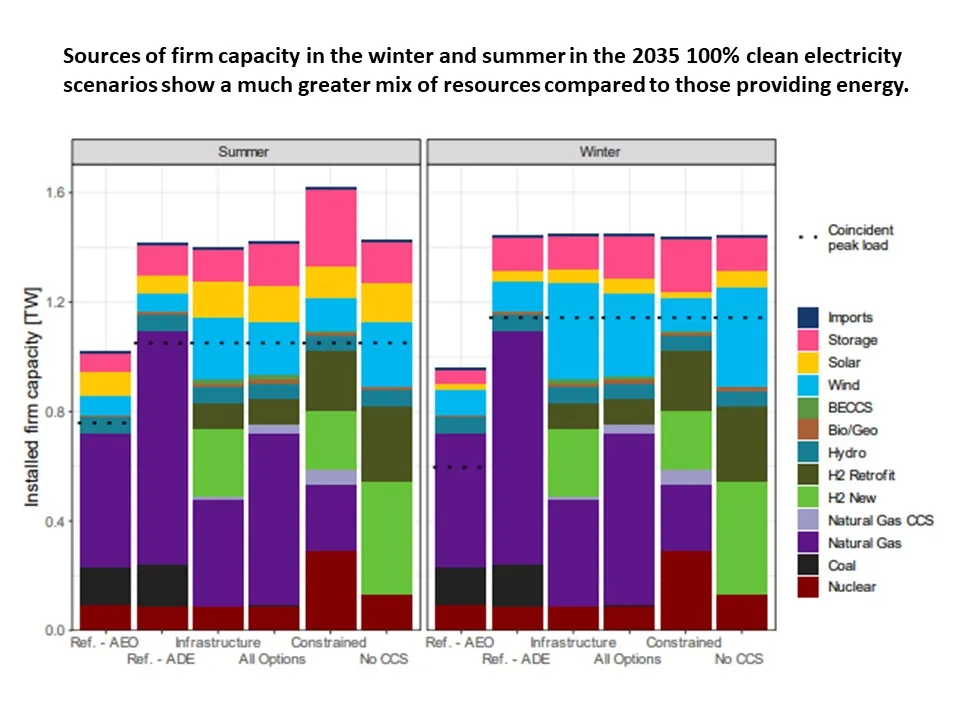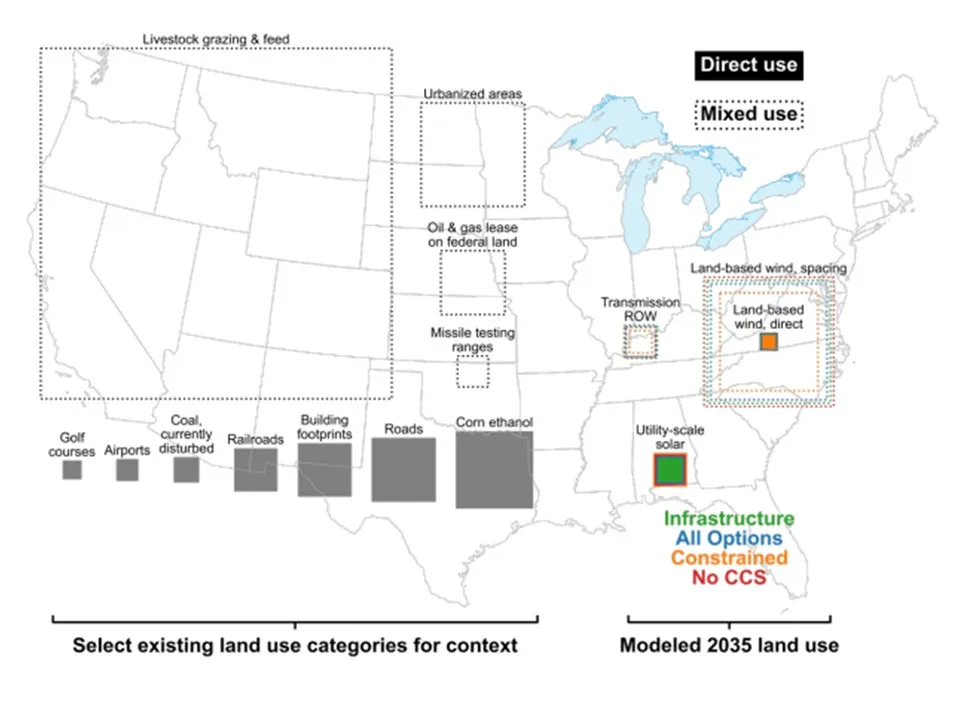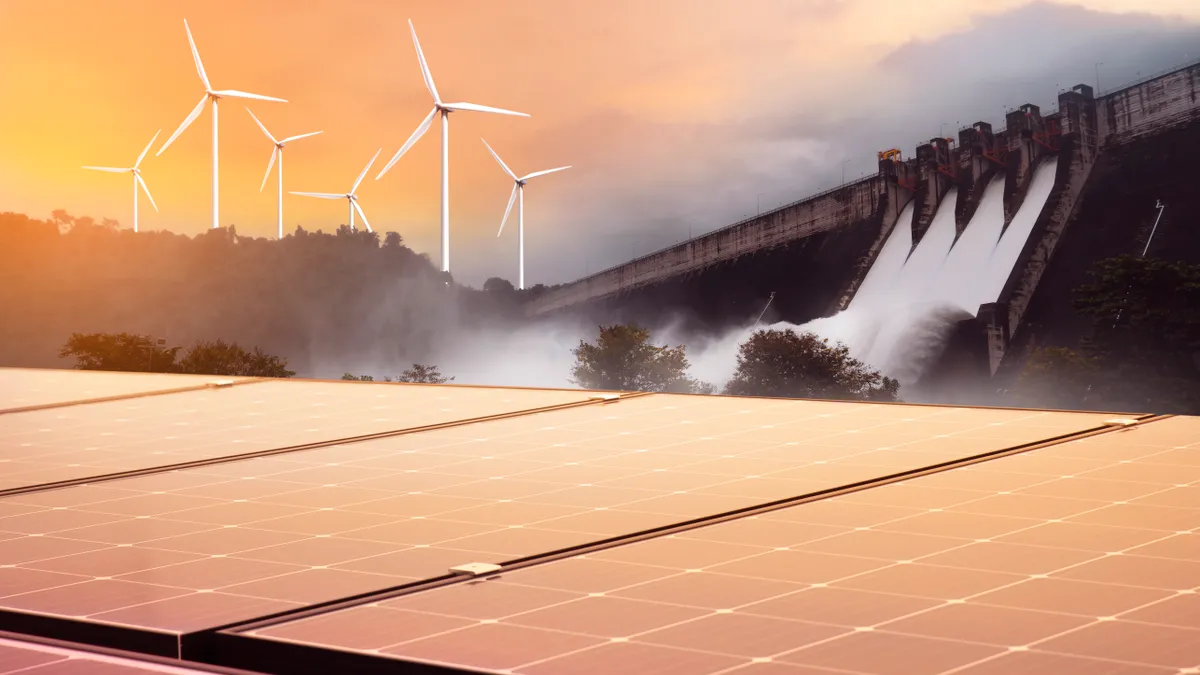Four major viable paths to a net zero emissions “clean electricity” power system by 2035 “in which benefits exceed costs” are detailed in an August study by the Department of Energy’s National Renewable Energy Laboratory, or NREL.
But it does not explain how adequate land to reach a 90% clean electricity penetration can be acquired or how reliability will be protected beyond that 90% penetration, stakeholders acknowledged.
Today’s clean energy technologies can take the U.S. “to about 90% emissions reductions because of reduced costs and our maturing understanding of renewables and storage,” said Paul Denholm, DOE principal energy analyst and study co-lead author. But “90% is a proxy for where we don't know what resource or multiple resources will be needed for reliability,” he said.
Markets may resolve uncertainties about long-duration energy storage, or LDES, technologies for reliability, DOE and storage analysts agreed. But resolving the continuing local opposition to building new infrastructure will require smarter planning, environmentalists said.
“Most people have not yet envisioned the coming scale of development and local permitting and siting challenges,” agreed Nicole Hill, project lead on The Nature Conservancy, or TNC, report Power of Place – West. But TNC’s new planning approach of “working slowly and responsibly now to be able to go faster later,” can achieve both climate and conservation goals, she said.
The full scale of needed infrastructure growth may be hard to envision, but new federal, state and utility LDES technology investments and proposed planning policy innovations are taking on the uncertainty, DOE’s Denholm and other analysts said.
Paths to 100%
The four paths to a 100% clean power sector by 2035, even with 66% higher demand from transportation and building electrification, can lead to a net zero emissions economy by 2050, the NREL study said.
One path assumes “improved cost and performance” of all zero emissions technologies, including carbon capture, NREL reported. Another assumes more transmission capacity from “improved transmission technologies” and “new permitting and siting approaches,” a third assumes higher costs from generation and transmission constraints, and the last assumes limited carbon capture.
The study focused on meeting needs with large-scale energy supply, but an alternative path could use more energy efficiency and demand-side flexibility, NREL added. Relying on those alternatives instead of building large-scale infrastructure lowers projected annual load growth nationally from 3.4% to 1.8%, with “lower demand peaks” and “winter peaks,” and uses more “clean” hydrogen in transportation, industry and generation, the study said.
Modeling included 2021 state and federal policies but not 2022’s Inflation Reduction Act, or IRA, and 2021’s Bipartisan Infrastructure Law, NREL said. Subsequent DOE analyses estimated those investments driven by those laws, in conjunction with other planned buildouts, can lower economy-wide emissions 40% from 2005 levels and grow clean energy 60% to 81% by 2030, but lead to no more than 78% power system emissions reductions by 2035, NREL found.
A combined 2 TW of new wind and solar, “roughly three times the 2020 level,” provide 60% to 80% of new generation by 2035, in NREL’s paths. Projected annual growth rates by 2030 of 43 GW to 90 GW for solar and 70 GW to 145 GW for wind, are “more than quadruple” current levels, it added.
Overall capacity in the four scenarios, which also included 5 GW to 8 GW of new hydropower and 3 GW to 5 GW of new geothermal by 2035, could be reduced 16% to 20% with more energy efficiency and distributed energy resources, NREL reported.
For reliability at “all hours of the year,” a total of 120 GW to 350 GW of 2 hour-to-12 hour “diurnal storage” will be needed by 2035, NREL estimated. It may be batteries, pumped storage hydropower, or technologies still being developed. Depending on power system uncertainties, an additional 100 GW to 680 GW of LDES will be needed at very high variable renewables penetrations, it added.
Nuclear is likely to be 9% to 12% of generation in 2035 under three of NREL’s scenarios but could more than double to 27% with siting and permitting constraints on generation and transmission, models found. But that is unlikely because the cost-effectiveness of investments in wind, solar, storage and transmission is “clearly” better than that of new nuclear, NREL’s Denholm said.
Between 1,400 miles and 10,100 miles of new high voltage transmission will be needed annually to achieve net zero power sector emissions in 2035, reaching “1.3 times to 2.9 times current capacity,” NREL estimated. Building the most transmission and wind has “the lowest average system cost,” it found in analyzing the pathways.
The “main uncertainty” is the technologies mix, modeling showed. With carbon capture viable, the scenario using all net zero emissions resources includes up to 5%, or 660 GW, of fossil fuels in the total 2035 generation. But more energy efficiency and DER reduced the need for new generation capacity “about 20%,” and both mixes reduced land needs and system costs, NREL found.
Health benefits from “substantial” fossil fuel reductions can provide “$390 billion to $400 billion” in total economic savings by 2035, NREL estimated. With the 2020 social cost of carbon, or SCC, of “about $80” per metric ton, rising to “about $100” in 2035, savings reached a total “net benefit” of $900 billion to $1.3 trillion over the projected $330 billion to $740 billion in “capital, fixed, and variable” power system costs, modeling estimated. Net benefits would be significantly higher with a more speculative $275 per metric ton SCC, NREL added.
But resource mix and cost uncertainties grow after 2030 with the need to meet growing diurnal and seasonal demand peaks from clean generation penetrations above 90%, NREL reported.

Molecules or electrons?
LDES choices beyond 2030 are largely between clean hydrogen fuels containing molecules produced from renewables and water or from natural gas with carbon capture, and clean energy projects generating electrons.
And “the future energy mix may be determined by how fast transmission for stored electrons and pipes for stored molecules are built,” said Jason Burwen, vice president of energy storage at the American Clean Power Association.
Through 2030, lithium-ion batteries of up to 10-hour durations and pumped hydro storage of up to 12-hour durations will become “increasingly cost-competitive” with natural gas plants for meeting ”mismatches” between renewables generation supply and load that last for 24-hour or less periods, NREL reported.
LDES, which NREL calls “seasonal” storage, is “represented” in the study by clean hydrogen fuels but could come from “a variety of technologies” still unproven at scale, NREL said. They include synthetic natural gas or ammonia fuels, new battery chemistries, thermal storage, compressed-air, pumped storage, or gravity-based technologies, it added.
Stored clean LDES can address the “seasonal mismatch” from rising summer and winter demand peaks as clean energy approaches 100% and electrification grows, LDES Council Executive Director Julia Souder, NREL’s Denholm, and others said. Storage depleted by use for extended high demand-low renewables periods in the summer or winter can be replenished by spring and fall renewables oversupplies to avoid curtailment and economic losses, they added.
Overall, LDES will be expensive, “but there is so much uncertainty” about firm resources like unproven-at-scale fossil generation with carbon capture “that comparison is speculative,” said Denholm. But some version of LDES “will be needed to achieve the 2035 target,” making investment “in demonstrations of potential technologies important now so they will be ready,” he said.
“Multiple solutions,” will be needed to reach the 2035 goals, agreed Jacob Susman, CEO and co-founder of Ambient Fuels, which supplies green hydrogen from renewables and water, and Nidhi Thakar, vice president of policy and regulatory at Form Energy, a developer of a groundbreaking 100-hour, multi-day iron-air battery chemistry.
There is no need for batteries and green hydrogen to compete while policy and market design are still being shaped, and “narrowing opportunity now will miss value later,” the LDES Council’s Souder added.
Access to adequate land is a more immediate concern creating uncertainty about meeting the 2035 net zero emissions power sector goal, stakeholders agreed.

Planning for land
The 2035 goals could require new generation at “three to six times” recent growth rates, new rights-of-way for “doubling or tripling” transmission, and “new pipelines and storage for hydrogen and CO2,” DOE found.
It is “doable” by “balancing environmental protections against carbon’s impacts” on climate change, Denholm said.
Permitting language was removed from September’s Continuing Resolution on government funding (H.R. 6833), while the Federal Permitting Reform and Jobs Act (S.2324), introduced by Senator Rob Portman, R-Ohio, in 2021 to streamline the infrastructure development, has not progressed. And the still uncompleted stakeholder process at the Federal Energy Regulatory Commission to reform transmission planning includes proposals to streamline permitting. But neither get at the innovative reforms really needed, stakeholders said.
Smart planning can protect “sensitive natural areas and working lands” and reach economy-wide net zero emissions cost-effectively by 2050, TNC’s Power of Place – West study agreed.
Without improved planning, the 2050 goal would require “up to 39 million acres” in the 11 studied states for new generation and transmission infrastructure and cost $260 billion, TNC’s modeling found. But with spatially specific regional, state and local planning and siting in pre-defined “priority renewable energy zones,” only 21 million acres would be needed, an almost 50% reduction, at an increased cost for all the extra siting and permitting work of only 3%, to $268 billion, it found.
Though made separately, TNC’s projections would likely represent a significant portion of the $330 billion to $740 billion in infrastructure development costs projected by NREL to achieve net zero emissions in 2035.
TNC identified where reconductoring upgrades and use of rights-of-way can meet half the new capacity needed for those states. That would limit additional land needed for rights-of-way for 16 GW of additional transmission capacity to 6,259 miles, only a 7% to 8% increase over current land used for the West’s 86,000 miles of transmission lines. Solar can be planned safely away from wildlife corridors and wind can be built offshore, it added.
“Power providers like Los Angeles County’s Clean Power Alliance, local governments like San Diego County, and private project planners are using these kinds of planning approaches,” TNC’s Hill said. And the strategies can be applied nationally, as shown by the priority renewable energy zones already used successfully for clean energy in California and transmission in Texas, she added.
Elements of TNC’s planning approach can accelerate development of Southwestern solar, Midwestern onshore wind, East Coast offshore wind, and inter-regional transmission nationally, agreed Natural Resources Defense Council Senior Renewable Energy Policy Analyst Nathanael Greene.
At least eight IRA provisions providing over $1.5 billion to under-resourced and understaffed federal permitting agencies can allow improved planning to streamline environmental reviews, Greene added.

But TNC’s approach may be “an optimistic outlook,” and underestimate the “intense opposition” in local communities to new infrastructure buildouts, the Los Angeles Times observed October 6.
“Local community opposition is real and will likely continue to make siting and permitting a challenge,” but might be addressable, said University of Notre Dame Associate Professor of Sustainable Energy Policy Emily Grubert, who has worked with federal agencies on related issues.
To earn a community’s trust, development proposals “should explain why a project is needed, why the community’s resources are needed, and how the community can benefit,” Grubert said. They should also “assure the community its concerns have been heard and it will be protected,” she added.
DOE’s formal Community Benefits Agreements, which are used for new infrastructure development and stipulate the benefits a developer will deliver for the community, “could also have a powerful impact on streamlining siting and permitting,” Grubert said.
“No project should go ahead without a Community Benefit Agreement to assure real benefits for the host community,” agreed NRDC’s Greene. But in many places, “political polarization has turned reasonable project development questions into obstructive, misinformation campaigns,” Greene said. “Overcoming that will take a lot of work,” he added.
“People, especially in smaller communities, can get very passionate, and even exchange death threats, which shows how important and undervalued trust is,” Grubert agreed.
California legislation jump-started battery storage growth in 2016 and its most recent planning mandates may do the same for LDES by calling for storage that protects system reliability, ACP’s Burwen said.
But at present even California’s advanced integrated energy resource planning process needs updating to recognize the need for climate and extreme weather adaptation and the new affordability of clean energy, said V. John White, executive director of the Center for Energy Efficiency and Renewable Technologies.
Long term planning in California and across the country must now focus on accelerating clean energy deployment because “the IRA has shifted the ground underneath us,” White said. It has turned new resource procurement into “an affordability strategy” because “the sooner low-cost clean resources are online, the sooner natural gas prices coming out of rates will allow customer bills to come down,” he added.
U.S. power system planning “still relies too heavily on natural gas,” which was the “root cause” of the February 2021 Texas outages, NREL’s Denholm agreed. “Not enough planning today addresses the changing peaks across seasons and times of day that will come with electrification” and “the need for transmission even where siting and permitting are barriers,” he added.
But the DOE study’s most critical finding “is that right now the answer is ‘yes’ to building any possible solar, wind, storage and transmission project as quickly possible to meet the national goals,” he said.





















